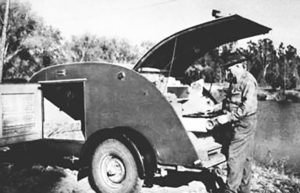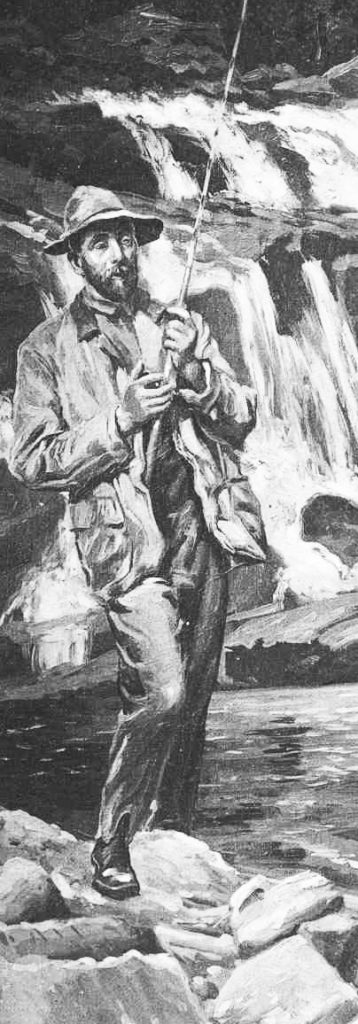~ PART 2 ~
 August 23, 1950 at 6 P. M. Richard N. Gaylord and Albert E. Fletcher started for Cape Breton Island and Nova Scotia driving a 1941 Chrysler Royal, and towing a sleeping trailer 3 1/2’ x 7’ x 2’.
August 23, 1950 at 6 P. M. Richard N. Gaylord and Albert E. Fletcher started for Cape Breton Island and Nova Scotia driving a 1941 Chrysler Royal, and towing a sleeping trailer 3 1/2’ x 7’ x 2’.
The story continues….
On August 26 we pulled out of our pasture and headed for Sherbrooke. We struck a road under construction which was our waterloo. We dragged the under part of the car so badly that the gas tank was broken open. Four miles later we came to Sherbrooke and had the remaining gas drawn out and the tank repaired. Two men worked one and one-half hours and charged us $3.00.
I talked with Mr. Manson about fishing in St. Mary’s River. He said the water was too low and too warm. Large salmon were in the pools but would not take a fly, the only way they may be taken. He recommended Margaree Forks in Cape Breton.
We left Sherbrooke and drove to the Forks at Melrose. We parked our trailer and went fishing in two large pools. Salmon would jump out of the water, within three feet of the shore, and very close to us standing in the water, trying so hard to hook one.
Dick and I were told that when Atlantic salmon reach fresh water they are covered with sea lice and rush through the weeds and jump in the air in an effort to cleanse themselves. These fish would weigh from ten to thirty pounds, 26” to 33” long, with beautiful silver gleaming bodies. How we tried to catch them!
I finally decided Dick and I should have some trout for breakfast. I took four trout from 9” to 14” in six casts, using my spinning outfit. We could have taken our limit in no time, but had no use for more.
The radio gave no indication of rain for some days so we decided to go to Margaree Forks, Cape Breton. Using “other roads” going north we happened to pass a field of fresh cut oats, when Dick spotted two deer across the field.
I took movies across 200 feet of oats and then started walking toward them to get a better picture. Believe it or not, I walked within 35 feet of these deer (two does) before they gave any indication of fear. The noise of the movie camera made them move (away from me, thank goodness) and run into the bushes, but I never shall forget the thrill I had walking up to these deer.
We then continued north to Antigonish, because the East Branch of the St. Mary’s River was practically  dry. We had dinner in this town. Took the ferry at Pork Hawkesbury. It cost $1.40 for the car, trailer and two people. We were now on dusty gravel roads again for seventy miles, headed for Cape Breton Island.
dry. We had dinner in this town. Took the ferry at Pork Hawkesbury. It cost $1.40 for the car, trailer and two people. We were now on dusty gravel roads again for seventy miles, headed for Cape Breton Island.
The ALA book describes the various towns as you travel through. Port Hood was a coal mining center, until water from the ocean broke through and closed the mines. Coal lies all over the roadsides. Rotting railroad trestles and coal loading shutes are all going to pieces. In a few years there will no evidence of coal handling or mining at this port.
Inverness, next to Port Hood, is a town of about 3000 people and an active coal mining center today.
We arrived at East Margaree at 3 P.M., and contacted “Art” Wenger, who runs a lunch room near Etheridge Pool. He located our trailer in a lot near the river and was our adviser and helper while we were there. We had a good many talks with “Art” and learned a great deal about the people and country nearby. He furnishes guides, fishing licenses, delivers mail and with is wife Elsie, a good sandwich, etc.
We found that the Margaree River was up the week before, but was low now, so decided to wait for rain. Dick and I fished the following pools eight hours a day: Wash Pool, Etheridge, Garden, Brook, Cranton, Seal, MacDaniers, Tent and Hatchery. During our stay several fish up to 25 pounds were taken, but we were not the lucky ones.
Fish could be seen lying against a ledge of stone on the side of the river, as still as though they were dead, or on some occasions rear into the air three or more feet and splash down, as though to prove you were stumped and they were the master.
We had about 200 flies of various patterns, and we bought local flies and tied some of our own, but to no avail. One night as we were sleeping with the trailer top pushed back, it started to rain, so we quickly closed the top. It rained for five hours, raised the river six inches, but not enough to start a run.
Dick did hook onto a fish in Wash Pool and the sudden rush snapped his leader very quickly, yet he got a wonderful thrill out of it. I took some pictures of a 19 pound salmon taken from a pool I was fishing.
The people of Nova Scotia and Cape Breton were very nice to us, helping in any way they could. In all our travels in this country we never saw one “no trespassing” sign. With people so friendly, even though you do not get salmon, you feel fine all the time.
As we toured around the countryside we would see deer quite often. We were startled one day by what we were told was a silver fox.
The Margaree River is composed of pools and intervales.
An intervale is a series of rapids in which there are no pools or fish. Salmon coming up the river will pause at the same spot each time, according to the guides.
The commercial fisherman use nets to catch salmon outside Margaree Harbor until August 15 of each year. They catch tons of them for canning.
We waited for more rain until Friday, September 1, and then decided to leave for home 935 miles away. The trip home was very favorable after we reached hard roads at Port Hawkesbury. We left East Margaree at 2:00 P.M. arriving at Amherst at 12:00 P.M. 257 miles. We parked our trailer at the old Fort again. Our next jump was to Portland where we slept in the trailer at the main gate of the Turnpike Road.
The commercial fisherman use nets to catch salmon outside Margaree Harbor until August 15 of each year. They catch tons of them for canning.
We waited for more rain until Friday, September 1, and then decided to leave for home 935 miles away. The trip home was very favorable after we reached hard roads at Port Hawkesbury. We left East Margaree at 2:00 P.M. arriving at Amherst at 12:00 P.M. 257 miles. We parked our trailer at the old Fort again. Our next jump was to Portland where we slept in the trailer at the main gate of the Turnpike Road.
We tried to buy twenty-five pounds of lobsters of three to four pound size, but were told it was too late in the season.
Dick and I arrived home at dusk Sunday, September 3, after travelling 2166 miles. It cost us $50.00 for gas, no oil, $20.00 for groceries, $10.00 licenses and $5.00 for incidentals. The total cost for two men was $85.00 for eleven days.
In conclusion I might say that I would write before I went up again and I would take the boat out of Boston for Halifax, Nova Scotia.
We had a wonderful time and shall always remember the friendly spirit of the people of Nova Scotia and Cape Breton.






